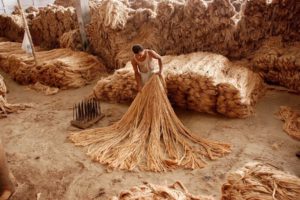Introduction of Jute: – Jute is important natural fiber cash crop just like cotton crop and grows well in hot and moist climate. In India, Ganga delta region is excellent for jute cultivation as this region has fertile alluvium soil & favorable temperature along with sufficient rainfall. India and Bangladesh is biggest jute producer in the world. Originally raw jute was using as raw material for packaging industries only, later it has emerged as source for paper industries, textile industries, building & automotive industries, soil saver, decorative and furnishing materials.
Local name for jute in India: – Jute/Mesta (Hindi), Senabu (Kannadad), Joot (Marathi) Chanapai (Tamil), Janapanara (Telugu), Shada pat (Bengali).
Types of Jute: – Olitorius and Capsularis.
Major Jute production states in India: – The major jute producers in India are: Bihar, Assam, Wes Bengal, Orissa and Meghalalya.
Commercial or Hybrid Varieties of Jute: – Following are the hybrid varieties of Jure.
Olitorius JRO 878, JRO 524, and JRO 7835
Capsularis JRC 7447, JRC 212 and JRC 321
Climate required for Jute cultivation: – Jute crop grows well in rain fed, moderate, war, humid atmosphere and sunshine conditions. 25° C to 30° C is ideal for jute cultivation. Jute cultivation requires about 160 cm to 200cm rainfall. Humid weather will result in good yield.
Soil requirement for jute cultivation: – River basins or alluvial or loamy soils are best for jute cultivation. Jute cultivation in red soils may require high dose of manure and ph range between 4.8 and 5.8 is best for its cultivation.
Land preparation in Jute Cultivation: – Plain land or gentle slope or low land is ideal for jute cultivation. Since the jute seeds are small in size, land should be prepared to fine tilth. Couple of ploughing will make the soil to fine tilth.
Best season to cultivate Jute crop: – Feb month of the year.
Jute crop Duration: – 4 months to 5 months.
Seed sowing & seed sowing in Jute cultivation: – There are two ways of sowing methods in Jute cultivation.Line sowing method
Broadcasting method
2. Seed rate is given Below.
Jute type/Variety Seed rate kg/ha Spacing No. of cm of plants/sq.Mt plants
Line sowing broad casting
Olitorius 5 7 25 X 5 85
Capsularis 7 10 30 X 5 70
Manures and fertilizers in Jute cultivation: – Add 5 to 8 tones of well decomposed farm yard manure (FMY) or compost at the time of soil/land preparation. Basal application of N 20 kg, K20 20kg and P205 20 kg should be carried out.
Irrigation in Jute cultivation: – Jute cultivation requires good water resource (500 to 600 mm of water) and plenty of sunshine. As soon as sowing is completed, carry out the first irrigation. Life irrigation should be given on 5th day after sowing. Subsequent irrigations should be given with 2 weeks interval.
Weed control in Jute cultivation: – Hand weeding has to be carried out twice in 3 weeks to 4 weeks after sowing and 5 weeks to 6 weeks after sowing. Herbicides like Fluchloralin should be sprayed @ 3 to 4 days after sowing @ the rate of 1.5 kg/ha and is followed by watering. One hand weeding can also be taken up @ 4 weeks to 5 weeks after sowing.
Top dressing in jute cultivation: – Add 10 to 12 kg of N @ 3 weeks to 4 weeks after first weeding and then again in 5 weeks to 6 weeks after second weeding as top dressing.
Harvesting of Jute: – Depending up on local cropping system, jute crop can reach harvesting stage @ 102 to 110 days after sowing, but it can also be extended to 140 days after sowing. Leave the jute plants in the field for 4 days for leaf shedding. Sort out thick & thin plants to make bundles in convenient sizes.
Yield of Jute: – With good farm management practices, Green plant yield can be expected up to 40 to 50 tones /ha and fiber yield up to 2.0 to 2.75 tones/ha.
| Year | Area (Million Hectares) | Production (Million Tonnes) | Yield (Kg./Hectare) |
| 2001-2002 | 1.05 | 11.68 | 2007 |
| 2002-2003 | 1.04 | 11.28 | 1960 |
| 2003-2004 | 1 | 11.17 | 2008 |
| 2004-2005 | 0.92 | 10.27 | 2019 |
| 2005-2006 | 0.9 | 10.84 | 2173 |
| 2006-2007 | 0.96 | 11.27 | 2170 |
| 2007-2008 | 0.94 | 11.21 | 2101 |
| 2008-2009 | 0.9 | 10.37 | 2071 |
| 2009-2010 | 0.91 | 11.82 | 2349 |
| 2010-2011 | 0.87 | 10.62 | 2192 |
| 2011-2012 | 0.9 | 11.4 | 2283 |
| 2012-2013 | 87 | 11.3 | 2338 |
